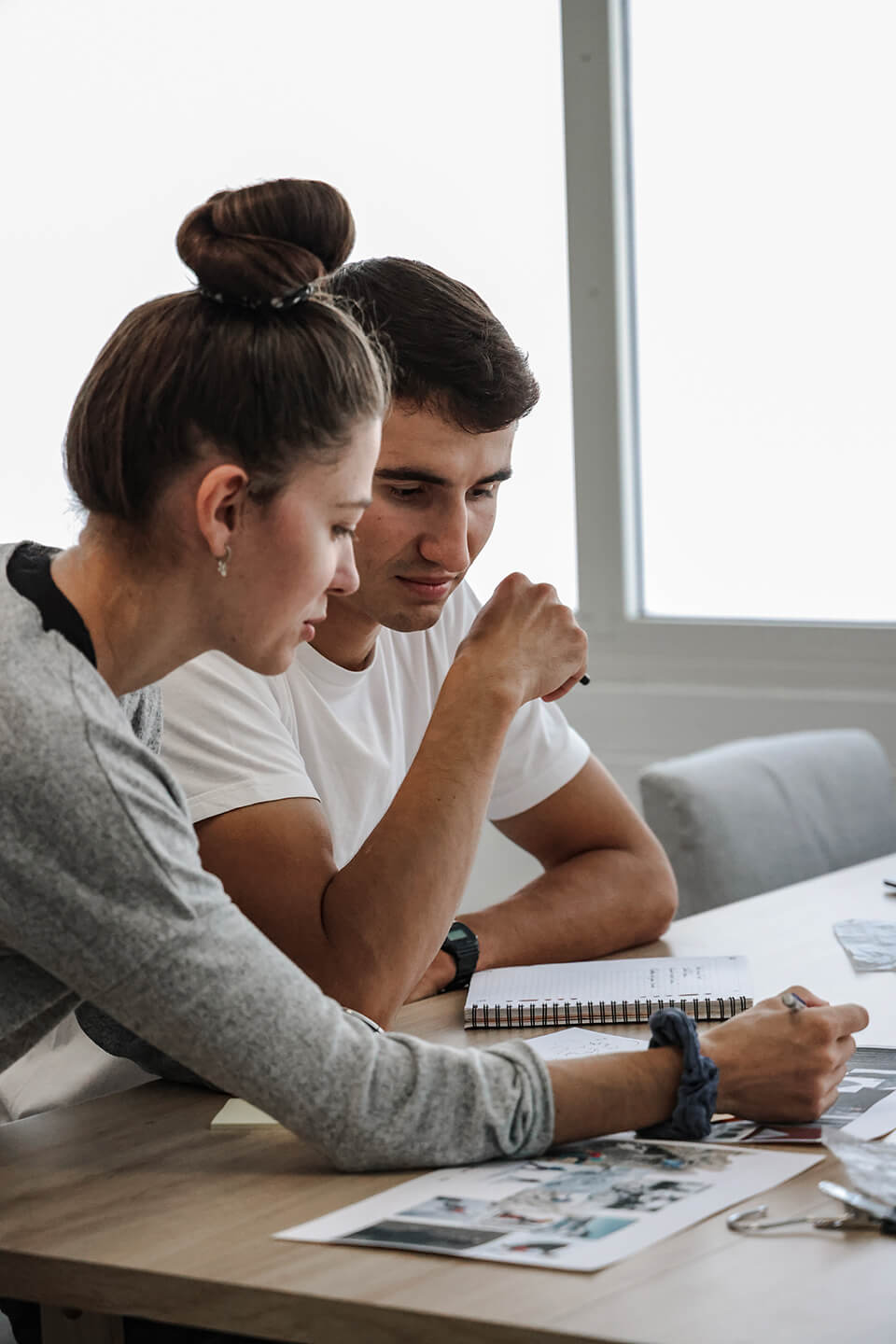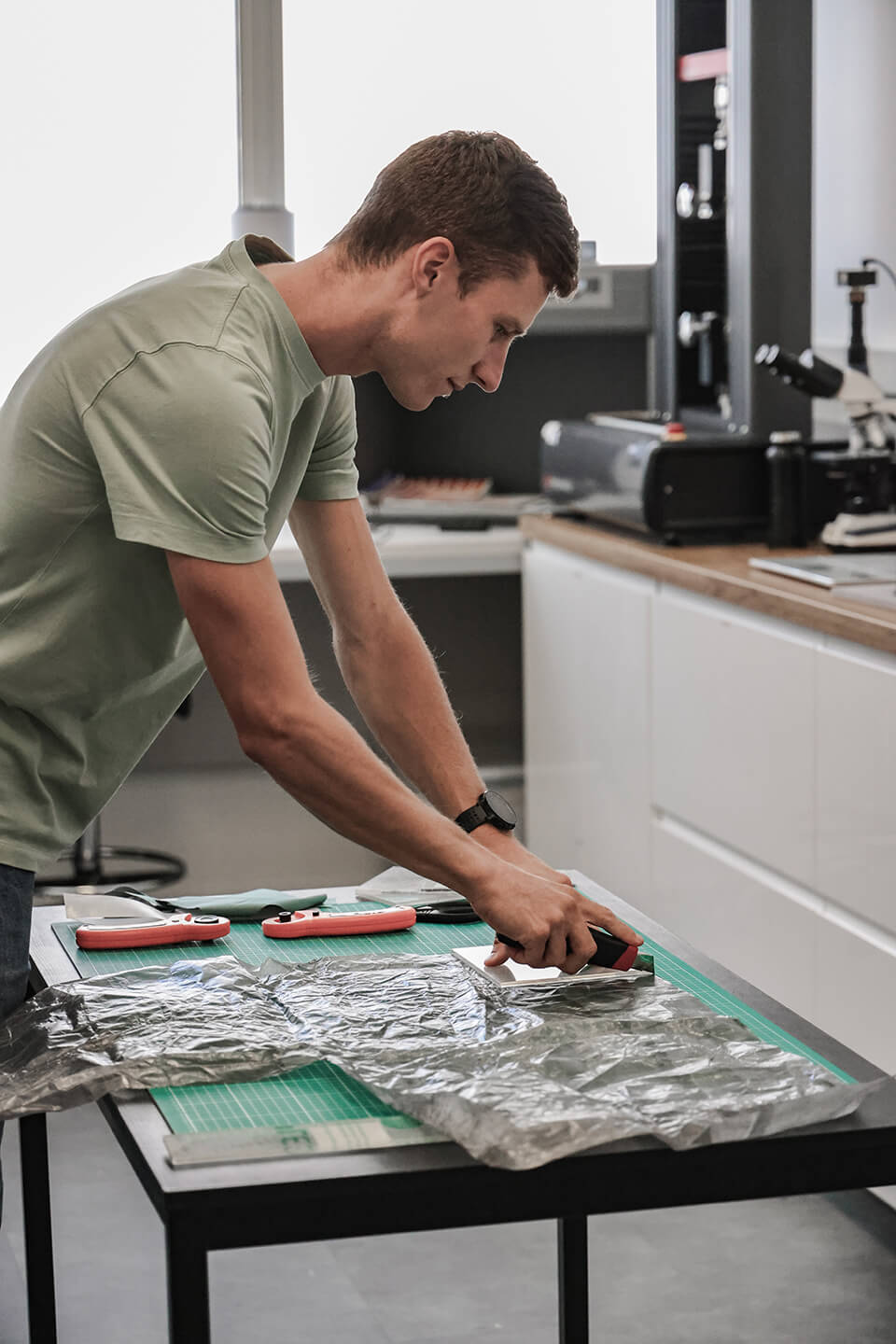

MINUTE R&D
DANS LES COULISSES DU DÉVELOPPEMENT PRODUIT

Imagination, conception, contraintes, matières et technologies sont au cœur de la démarche de création de nouveaux produits. Adrien Guillon, Responsable Développement & Marketing Produits et Antoine Tirmarche, Responsable Matières, nous plongent dans les coulisses du développement d’une nouvelle gamme de produits.
Adrien Guillon : On se projette sur plusieurs années à l’avance ! On décide d’abord de la direction à prendre et de ce à quoi on voudrait que la marque ressemble demain. On commence à poser des concepts de produits, des aspirations personnelles, des retours ou recommandations d’athlètes ou encore des manques à combler par rapport au marché. Ensuite, on met de l’ordre dans nos idées et on les challenge. On se demande pourquoi personne n’a jamais fait ça avant et on écarte les idées qui nous paraissent inutiles. On réfléchit par cohérence de gamme et sur les valeurs que l’on souhaite véhiculer. On doit également dimensionner la gamme en fonction des contraintes et des équipes. Une fois le plan posé, on liste les besoins : briques technologiques, contraintes associées, moyens nécessaires. Même si tout est « planifié », rien n’est immuable et un produit pourra être repoussé si nous ne le jugeons pas abouti dans le temps imparti.
AG : Plusieurs contraintes s’additionnent. Lors de la création d’un nouveau produit, on fait face à la contrainte des briques technologiques, c’est-à-dire tout le savoir-faire nécessaire à la réalisation de ce nouveau produit. Ce processus nous fait passer par des phases de recherche puis de développement de nouvelles technologies, comme pour notre membrane imper-respirante. Ensuite, il y a la contrainte du timing. Il faut parvenir à développer un produit fini en temps et en heure par rapport au planning de sortie sur le marché, tout en incluant les différentes phases de développement, prototypage, tests terrains et retours athlètes.
On a également la contrainte de la supply chain, qui impose d’avoir les bons fournisseurs et les bonnes usines, capables de réaliser nos produits dans toute leur technicité.
Les minimums de quantités représentent également un élément primordial dans ce processus. Travaillant sur des produits d’exception à usages très spécifiques, nos volumes sont de facto plus réduits que la norme. Nous devons cependant assurer un minimum de quantité produite pour être en mesure d’assurer une production industrielle et avant cela, de commander une quantité de matière suffisante aux yeux de nos fournisseurs (notamment en cas d'un développement sur mesure).
Le prix est aussi un facteur clé. Réussir à maintenir un prix de production viable à la commercialisation du produit est indispensable et constitue une lourde contrainte lorsque l’on compose avec des matériaux haut de gamme.
Finalement, notre dernière contrainte est celle de réussir à lier le besoin de performance spécifique de nos athlètes avec les besoins de nos clients, qui parfois diffèrent.


Antoine Tirmarche : D’abord, le brief produit impose un usage spécifique et donc des contraintes liées à son environnement, ce qui oriente notre sélection des matières et technologies à employer sur le produit. S'il s'avère que des matières ou technologies que nous utilisons déjà sont adaptées au nouveau produit, nous les sélectionnons, car elles ont déjà été éprouvées sur le terrain. On y trouve de la cohérence et de l’intemporalité.
Dans le cas contraire, nous nous lançons dans une boucle de développement. Celle-ci se caractérise d’abord par l’établissement d’un cahier des charges (CDC) pour ces matières et technologies, en adéquation avec les besoins fonctionnels du produit. Les matières sont sourcées et/ou développées en accord avec ce CDC chez nos fournisseurs. Ensuite, elles sont testées en laboratoire (performance pure) et sur le terrain (durabilité) afin de valider leur viabilité pour le produit. Enfin, on utilise ces matières lors de la phase de prototypage pour les éprouver sur des produits en utilisation réelle.
Dans certains cas, une « simple » boucle de développement ne suffit pas à obtenir une matière ou une technologie dans les temps. Ainsi, comme le plan de collection est disponible avec quelques saisons d’avance, les besoins en matières et technologies complexes sont directement identifiés. Ainsi, des actions de R&D plus « complexes » qu’à l’ordinaire peuvent être envisagées, donnant lieu à des projets qui s’étendent sur plus d’une saison.
AG : Avant tout, nous souhaitons que nos produits reflètent les valeurs de la marque : performance, attention au détail et ergonomie. Le « beau » et le sens de l’esthétisme, bien qu’il s’agisse de notions subjectives, sont aussi au cœur du développement. Très attachés à notre ADN alpin, les produits Samaya sont pensés pour répondre aux besoins fonctionnels de la pratique, tout en respectant un certain style et une approche caractéristique de la montagne, ce qui se traduit par exemple par l’expression d’une certaine pureté dans le design avec une touche d’audace dans les couleurs ! En utilisant un produit Samaya, on appréhende l'environnement en s’intégrant dedans et non l’inverse !




